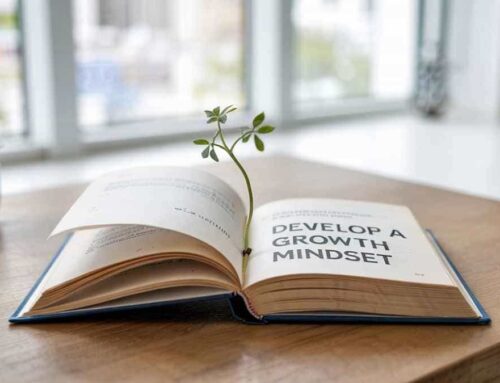
Developing a Business Mindset
In today’s fast-paced, competitive world, cultivating a business mindset is essential for anyone looking to thrive in their professional endeavors. Whether you’re an entrepreneur, a manager or an employee aspiring to climb the corporate ladder, understanding and developing a business mindset can significantly impact your success. This article explores the key principles that define a business mindset and provides practical strategies for adopting and nurturing this crucial way of thinking.
-
Understanding the Business Mindset
A business mindset is a way of thinking that prioritizes strategic planning, innovation and continuous improvement. It involves a focus on goals, an openness to learning and a proactive approach to problem-solving. Individuals with a business mindset are not just employees or business owners; they are leaders who drive progress and inspire change within their organizations.
Characteristics of a Business Mindset
- Goal-Oriented: Setting clear, achievable goals and consistently working towards them.
- Strategic Thinking: Looking at the bigger picture and planning for long-term success.
- Adaptability: Being flexible and open to change, ready to pivot when necessary.
- Innovation: Continuously seeking new ideas and ways to improve processes.
- Resilience: Overcoming setbacks and learning from failures.
- Customer Focus: Prioritizing customer needs and satisfaction.
- Financial Acumen: Understanding financial principles and their impact on business decisions.
-
Setting Clear Goals and Objectives
The foundation of a business mindset lies in setting clear, measurable goals. Without a defined direction, it is easy to lose focus and motivation. Goals provide a roadmap, guiding individuals and teams towards desired outcomes.
SMART Goals
One effective method for goal-setting is the SMART criteria, which ensures that goals are:
- Specific: Clearly defined and unambiguous.
- Measurable: Quantifiable, allowing for tracking progress.
- Achievable: Realistic and attainable.
- Relevant: Aligned with broader business objectives.
- Time-Bound: Having a specific deadline.
Long-Term vs. Short-Term Goals
Balancing long-term and short-term goals is crucial. Long-term goals provide a vision for the future, while short-term goals offer immediate targets that keep momentum going. By aligning short-term efforts with long-term objectives, individuals can maintain focus and drive continuous progress.
-
Strategic Thinking and Planning
Strategic thinking involves analyzing situations from various angles and making informed decisions that benefit the business in the long run. It requires foresight, creativity and a deep understanding of the industry and market dynamics.
Analyzing the Market
Understanding market trends, customer preferences and competitor strategies is essential for making strategic decisions. Tools such as SWOT analysis (Strengths, Weaknesses, Opportunities, Threats) can help in assessing the internal and external factors affecting the business.
Developing a Strategic Plan
A strategic plan outlines the steps needed to achieve business goals. It includes defining the mission and vision, setting objectives and identifying the resources and actions required. Regularly reviewing and adjusting the plan ensures that it remains relevant and effective.
-
Embracing Adaptability and Innovation
In today’s rapidly changing business environment, adaptability and innovation are critical. Businesses that fail to evolve risk becoming obsolete.
Cultivating a Growth Mindset
A growth mindset, popularized by psychologist Carol Dweck, is the belief that abilities and intelligence can be developed through dedication and hard work. This mindset encourages individuals to embrace challenges, persist in the face of setbacks and see effort as a path to mastery.
Fostering Creativity
Encouraging creativity within the workplace can lead to innovative solutions and improvements. Providing employees with the freedom to experiment, fail and learn from their mistakes fosters a culture of innovation.
-
Building Resilience
Resilience is the ability to bounce back from adversity. In business, setbacks and failures are inevitable. Developing resilience helps individuals and organizations recover quickly and continue moving forward.
Learning from Failure
Viewing failure as a learning opportunity rather than a defeat is crucial. Analyzing what went wrong and identifying lessons can prevent similar mistakes in the future and contribute to growth.
Maintaining a Positive Attitude
A positive attitude can significantly influence resilience. Optimism and confidence in one’s abilities can help navigate challenges and inspire others within the organization.
-
Focusing on the Customer
Customer satisfaction is at the heart of any successful business. Understanding and meeting customer needs not only retains existing customers but also attracts new ones.
Gathering Customer Feedback
Regularly seeking feedback from customers provides valuable insights into their preferences and pain points. This information can guide product development, service improvements and overall business strategy.
Delivering Exceptional Service
Providing exceptional customer service involves going above and beyond to meet customer expectations. Training employees to handle customer interactions professionally and empathetically ensures a positive customer experience.
-
Enhancing Financial Acumen
A solid understanding of financial principles is essential for making informed business decisions. Financial acumen involves budgeting, forecasting and analyzing financial statements.
Budgeting and Forecasting
Creating and managing a budget helps allocate resources effectively and track financial performance. Forecasting future revenues and expenses allows for proactive planning and risk management.
Analyzing Financial Statements
Regularly reviewing financial statements such as income statements, balance sheets and cash flow statements provides insights into the financial health of the business. Understanding these documents helps in making strategic decisions and identifying areas for improvement.
-
Continuous Learning and Development
The business landscape is constantly evolving and staying updated with the latest trends and skills is crucial. Continuous learning and development ensure that individuals remain competitive and capable of driving business success.
Pursuing Professional Development
Investing in professional development through courses, workshops and certifications can enhance skills and knowledge. Encouraging employees to pursue learning opportunities benefits both the individual and the organization.
Staying Informed
Keeping up with industry news, trends and technological advancements is essential for making informed decisions. Reading industry publications, attending conferences and networking with peers can provide valuable insights.
Conclusion
Developing a business mindset is a journey that requires dedication, effort and a willingness to adapt. By setting clear goals, thinking strategically, embracing innovation, building resilience, focusing on the customer, enhancing financial acumen and committing to continuous learning, individuals can cultivate a mindset that drives business success. This mindset not only benefits the individual but also contributes to the growth and prosperity of the organization as a whole.
In a world where change is constant, having a business mindset is more important than ever. It empowers individuals to navigate challenges, seize opportunities and lead their organizations towards a successful and sustainable future.














